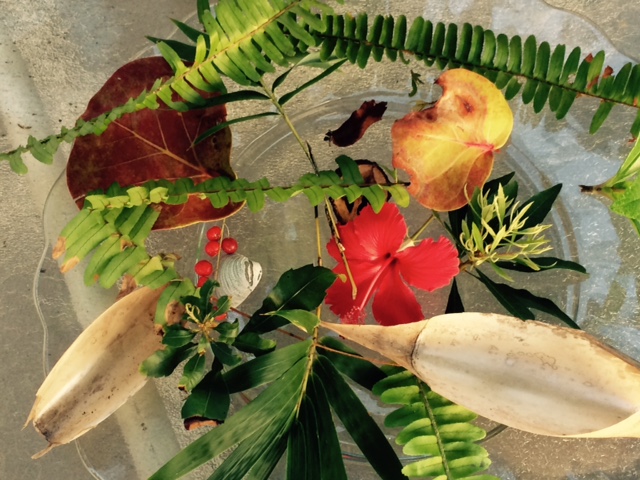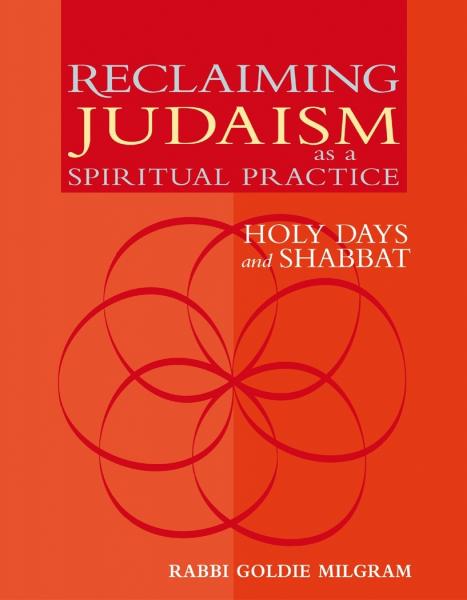 co-created by Kayla Niles and Rabbi Goldie Milgram
co-created by Kayla Niles and Rabbi Goldie Milgram
Haggadah for
Tu B’Shevat during Shmitah 5775
co-edited by Kayla Niles and Rabbi Goldie Milgram
|
What principles can we derive from Jewish tradition about our environmental crisis?” |
|
|
|
· When humans are destructive, nature reacts. · There is order and inter-relatedness throughout creation. · It is a mitzvah to refrain from destruction of the environment: · "We have to get back to the Garden." · Earth is "the Garden". · Our responsibility is to tend "the garden". · For sure one meaning of "the world-to-come" is this world,
|
|
Background on Shmitah: Judaism provides cycles of seven days and years that contain practices that are core to health, awareness and healing: · One day of rest out of every 7 days is our Sabbath and Pesach and Sukkot are our weeklong festivals. · Shiva is the term for the practices of the first seven (sheva) days of mourning. · The Omer is comprised of 7 weeks x 7 days=49 days of reflection from Passover to Shavuot. · Shmitah is the one-year out of seventh of rest for the fields and certain forms of debt. See Exodus 23:10-11, Leviticus 25:1-7 and Deuteronomy 15:1-2, 7-10. · Finally there is also the Yovel—the Jubilee year, one year after every 7 times 7 years: 49 years that includes liberating agricultural and economic spiritual practices. |
|
|
Background onTu B'Shevat: Worldwide today's Jews have made Tu B'Shevat into our "arbor day" a festival dedicated to advancing caring and commitment to the wellbeing of the earth and the environment. Contemporary Israelis and Zionists also take this as a day of celebration of living on the land, raising funds for reforestation, and eating fruits from the land of Israel. (Carob, by the way, became traditional because it travelled so well from Israel to the diaspora.) |
|
|
1. Opening Song of Awareness
We’ve got the trees and the tigers in our hands, We’ve got the whole world in our hands. We’ve got the wind and the oceans in our hands,
|
|
|
The Four Questions of Tu B’Shvat |
|
|
The sight of the many types of fruits for Tu B’Shevat inspires us to ask questions, just as we do on Pesach.
1. Why on Tu B’Shevat do we have a special holiday for trees? |
|
I. ASSIYA
(Earth, Actuality, Action)
The Physical World
This world is associated with winter, a time of dormancy in nature when snow blankets the earth. It is represented by white wine.
Earth is the rhythm of our feet on the Mountain. In this world, we bless the physical: our bodies, our land, our homes. It is our connection to the Earth that inspires Action.–Ellen Bernstein
FIRST CUP. White Wine or juice from a fruit of the vine.
Ba-ruch ata A-do-nai e-lo-hei-nu me-lech ha-olam bo-rei pree ha-gafen
We bend our knees at the Pond of Blessings at the Threshold of Eternity blessing the fruit of the vine. Kabblistic interpretation based on Shaarei Ora by Gikatilla: –Rabbi Goldie Milgram
CONCERN
“SHmmmm, mmmmmm, aaaaahhhhhhh." Listen deeply—we are told to listen straight to our Godsense (yashar-El) where we know All IS One.
For when we respect the interdependence of all that lives and engage in mitzvah-centered rather than self-centered lives, the rains will come in season, the crops will flourish and be gathered in season, and the cattle will be able to nourish themselves on the grasses they need.
But if we leave the path of mitzvah, of the practices designed to keep humans aligned in healthy and holy ways for the good of all that is, when we move into the idolatry of materialism, using up the earth and polluting the environment, the heavens will turn against us, the earth will swallow us and we will perish from a once good land.
— Deut. 11: 13-17, interpretive translation Rabbi Goldie Milgram
SONG
Tzadik ka' tamar yifrach
K’erez ba’levanon yisgeh
Shetulim b’veit Adonai
B’hatsrot Eloheinu yafrichu
Ode y’nuvune b’seivah
D’sheinim v’raananim y’hiyu
L’hagid ki yashar Adonai
Tzuri v’lo avlata bo
--from Psalm 92
A tzaddik (honorable person) can flower
like a cedar flourishes in its purity.
Planted in the House/
of Infinite Possibilities (YHVH*)
in the courtyards of our G*d-sense
it comes blossoming.
Even more so with age
will tzaddik-consciousness
bear fruit, vigorous and fresh.
—Interpretive translation by Rabbi Goldie Milgram
ACTION
Collect something from nearby (outside) to represent the earth that you can place on or near our seder plate.
FRUIT
For Assiya, we eat fruits with hard outer shells and soft, vulnerable insides, e.g, tree nuts,
DISCUSSION
What are the blessings and responsibilities these fruits evoke?
Ba-ruch ata A‑do‑nai El‑o‑hei‑nu mel‑ech ha‑olam bo-rei pree ha‑etz
We bend our knees at the Pond of Blessings at the Threshold of Eternity blessing the fruit
of the tree. Kabbalistic interpretation –Rabbi Goldie Milgram
II. YETZIRAH
(Water, Formation, Relationship): The World of Emotion
As spring approaches, the sun’s rays begin to thaw the frozen earth. Gradually, the land changes its colors from white to red, as the first flowers appear on the hillsides. So, our second cup will be a bit darker. We pour a little red wine into the white.--Ellen Bernstein
SECOND CUP: White wine or juice from the fruit of the vine.
Ba‑ruch ata A‑do‑nai El‑o‑hei‑nu mel‑ech ha‑olam bo-rei pree ha-gafen
CONCERN
“Hydrofracking pollutes land, air and water. About half of the millions of gallons of water used to frack the wells remains underground, untreated. Pipes and casings are supposed to contain it, but over time cement shrinks and metal corrodes. The other half of the water is stored in tanks or open pits that are vulnerable to leaks. This water is supposed to be treated, but few facilities are prepared to handle it…So to safeguard the water we drink, we have to find another source of energy…. The short-term goal is to ban fracking, the long term goal is to mobilize the political will to replace our current dangerous, shortsighted, fossil-fuel based energy system with a system based on renewable energy."
--Mirele Goldsmith, http://www.huffingtonpost.com/mirele-b-goldsmith-phd/my-fracking-nightmare-jewish-dream-interpretation_b_1325282.html
FOR REFLECTION AND ACTION [Place a crystal clear bowl of water on the table]
Share memorable experiences with living waters and then, together:
KAVANNAH: (Together) We dip our fingers and touch our lips to seal our commitment to the mitzvah of Bal Tashchit – refraining from damaging water and earth.
"The seder ritual I find most meaningful is washing my hands as the priests did before they performed a sacrifice. As I raise my hands to recite a blessing I remember that everything I will eat and drink contains water.”-- “Keep The Frack Out of My Challah” and “My Fracking Nightmare and a Jewish Ritual of Dream", Mirele Goldsmith
SONG
U'shavtem mayim b’sasson mi my'nei ha-yeshua(2x)
Mayim (4) Hey mayim b'sasson (2x)
Hey (4x) Mayim (6x) b’sasson
Mayim (6x) b’sasson
Draw water in joy/ from the Living Well/Water in joy!
--traditional Jewish folk song melody with interpretation of Rabbi Aryeh Hirshfield
FRUIT
For Yetzirah, we eat fruits with a tough inner core and a soft outer skin such as dates and olives.
Ba-ruch ata A‑do‑nai El‑o‑hay‑nu mel‑ech ha‑olam bo-ray p'ree ha‑etz
III. BRIYAH (Air, Creativity, Memory) The World of Intellect
"In summer, when vegetable and fruits are abundant, we are reminded of the richness of life, filled with color. We drink red wine with a dash of white."—Ellen Bernstein
THIRD CUP Red wine or juice to which enough white wine or juice is added for a lighter shade.
Ba-ruch ata A-do-nai E-lo-hay-nu me-lech ha-olam bo-ray pree ha-gafen.
CONCERN "The quality of urban air compared to the air in the deserts and forests is like thick and turbulent water compared to pure and light water. In the cities with their tall buildings and narrow roads, the pollution that comes from their residents, their waste makes their entire air reeking and thick, although no one is aware of it. Because we grow up in cities and become used to them, we can at least choose a city with an open horizon. And if you have no choice, and you cannot move out of the city, try at least to live upwind. Let your house be tall and the court wide enough to permit the northern wind and the sun to come through, because the sun thins out the pollution of the air." – Moses Maimonides, "The Preservation of Youth": The Guide to Health, pp. 70-71.
FOR REFLECTION AND ACTION
We will read these words, begin the chant below, and go out among the trees in contemplation:
“The unity of human and tree which is the basis of the Kabbalistic Tu B’Shvat seder is not just a metaphor for how important trees are to us, but a meditation on the idea that both trees and human creatures are patterned after the life of the cosmos. By examining humans and trees together, we may understand something deeper about the meaning of the life we are given and its place in the life of the world.” --Rabbi David Seidenberg , from “The Human, the Tree, and the Image of God,” in Trees, Earth, and Torah)
CHANT: Neshama, neshima (2x)/ I breathe in my life begins/I breathe out my soul travels on
--Rabbi Goldie Milgram
E-mail Rebgoldie@gmail.com and I will sing this to you, your cell-phone or answering machine.
FOR REFLECTION AND DISCUSSION:
This world is associated with summer and by fruits that are soft throughout and entirely edible such as figs and berries. Why are these fruits appropriate for this world?
Ba-ruch ata A-do-nai E-lo-hei-nu me-lech ha-olam bo-ray pree ha-adama, [or] ha-etz , depending upon the type of fruit on your table.
http://www.berachot.org/halacha/17_fruitsandvegetables.html (to see ambiguity of which blessing for berries)
IV: ATZILUT (Being, Essence, Spirit): The World of Fire
This world is associated with autumn, the season of abundance and teshuvah—entering the crucible of healing of relationships.
FOURTH CUP: Our best red wine.
Ba‑ruch ata A‑do‑nai El‑o‑hei‑nu melech ha‑olam bo-ray pree ha-gafen
When one brings a better kind of wine to the table one continues with this special blessing
(ha-meitiv) following the traditional blessing over the wine:
Ba-ruch atah A-do-nai E-lo-hei-nu me-lech ha-olam ha-tov v-ha-meitiv
Bending our knees at the Pond of Blessing at the Threshold of Eternity where that which is good and the Source of goodness are.
CONCERN (As metaphor for our circumstances now)
“For behold, the day is coming, burning like an oven, when all the arrogant and all evildoers will be stubble. The day that is coming shall set them ablaze, says the Lord of hosts, so that it will leave them neither root nor branch.—Malachi 4:1
FOR DISCUSSION AND ACTION
For Atzlilut we enjoy fragrance as we do at the end of every Shabbat during Havdalah.
Fragrance helps to seal memory.
ACTION: Let us recall and share a memory of a fragrance that holds meaning and beauty for each of us.
KAVANNAH: (Together) May these memories inspire us to create a fragrant world, free of pollution and destruction.
We conclude this seder with the Shemita Blessing and a song of Eliyahu and Miriam, the prophetic figures who inspire our vision of better times.
"May the merciful One turn our hearts toward the land,
so that we may dwell together with her in her Sabbath rest,
the whole year of Shmita."
Harachaman hu yashiv libeinu el ha’aretz
l’ma’an neisheiv yachad imah b’shovtah,
kol sh’nat hash’mitah! --from neohasid.org
|
Eliyahu ha-navi, Eliyahu hatishbi |
Miriam ha-n'vi'ah oz v'zimrah b'yadah.
|

Learn more about Jewish holy days
in Reclaiming Judaism as a Spiritual Practice;
Holy Days and Shabbat by
Rabbi Goldie Milgram